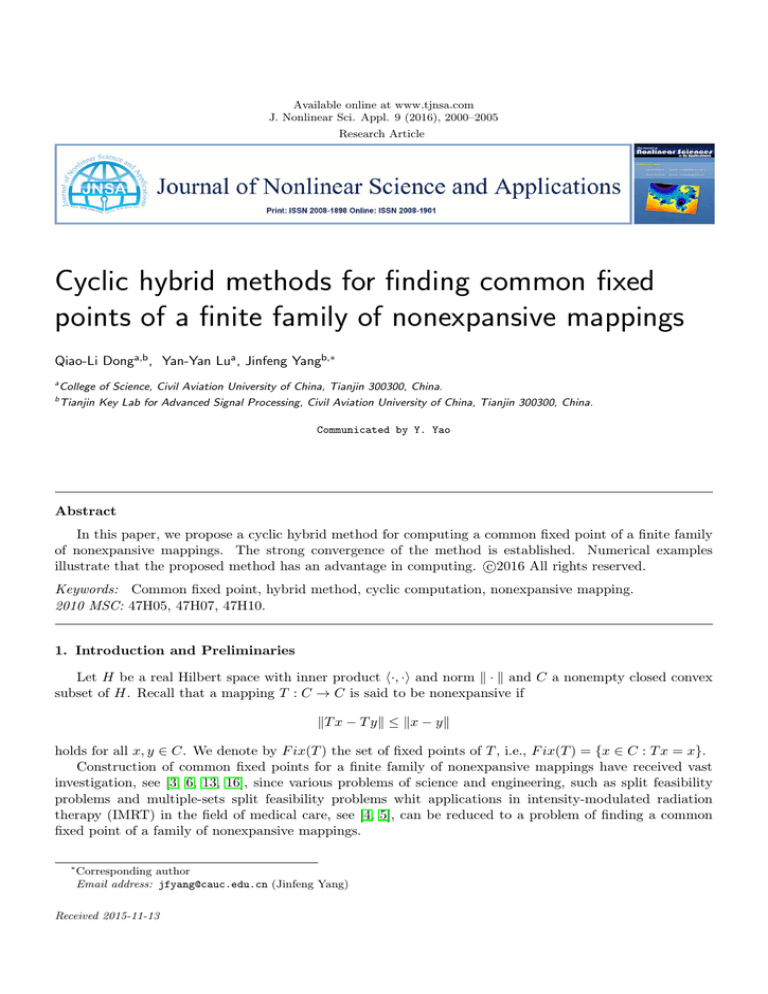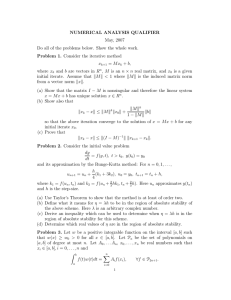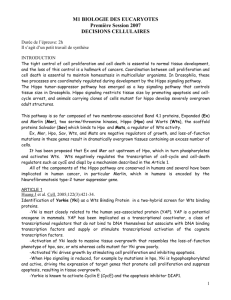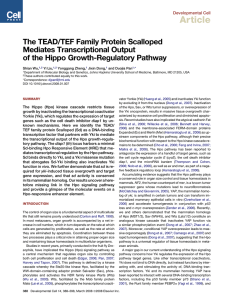
Available online at www.tjnsa.com
J. Nonlinear Sci. Appl. 9 (2016), 2000–2005
Research Article
Cyclic hybrid methods for finding common fixed
points of a finite family of nonexpansive mappings
Qiao-Li Donga,b , Yan-Yan Lua , Jinfeng Yangb,∗
a
College of Science, Civil Aviation University of China, Tianjin 300300, China.
b
Tianjin Key Lab for Advanced Signal Processing, Civil Aviation University of China, Tianjin 300300, China.
Communicated by Y. Yao
Abstract
In this paper, we propose a cyclic hybrid method for computing a common fixed point of a finite family
of nonexpansive mappings. The strong convergence of the method is established. Numerical examples
c
illustrate that the proposed method has an advantage in computing. 2016
All rights reserved.
Keywords: Common fixed point, hybrid method, cyclic computation, nonexpansive mapping.
2010 MSC: 47H05, 47H07, 47H10.
1. Introduction and Preliminaries
Let H be a real Hilbert space with inner product h·, ·i and norm k · k and C a nonempty closed convex
subset of H. Recall that a mapping T : C → C is said to be nonexpansive if
kT x − T yk ≤ kx − yk
holds for all x, y ∈ C. We denote by F ix(T ) the set of fixed points of T , i.e., F ix(T ) = {x ∈ C : T x = x}.
Construction of common fixed points for a finite family of nonexpansive mappings have received vast
investigation, see [3, 6, 13, 16], since various problems of science and engineering, such as split feasibility
problems and multiple-sets split feasibility problems whit applications in intensity-modulated radiation
therapy (IMRT) in the field of medical care, see [4, 5], can be reduced to a problem of finding a common
fixed point of a family of nonexpansive mappings.
∗
Corresponding author
Email address: jfyang@cauc.edu.cn (Jinfeng Yang)
Received 2015-11-13
Q. Dong, Y. Lu, J. Yang, J. Nonlinear Sci. Appl. 9 (2016), 2000–2005
2001
In 2003, Nakajo and Takahashi [12] firstly introduced a hybrid algorithm for a nonexpansive mapping,
thereafter, several researchers generalized the hybrid methods for computing common fixed points of a family
of nonlinear mappings, see [7, 8, 14, 17, 18, 21]. For a finite family of relatively nonexpansive mappings
{Ti }N
i=1 , Anh and Chung [1] recently proposed a parallel hybrid algorithm as following:
Algorithm AC
x0 ∈ C chosen arbitrarily,
zk := PC (xk ),
yki := αk zk + (1 − αk )Ti (zk ), i = 1, 2, · · · , N,
ik := argmax {kyki − xk k},
i=1,2,··· ,N
Ck := {v ∈ H : kv − ykik k ≤ kv − xk k},
Qk := {u ∈ H : hx0 − xk , xk − ui ≥ 0},
xk+1 := PCk T Qk (x0 ).
(1.1)
Algorithm AC is inherently parallel and Anh and Chung showed their advantage in parallel computation
in numerical examples.
Motivating by Anh and Chung’s work, we proposed a cyclic hybrid method which can be regarded as
a counterpart of the parallel one. Our ideas consists of determining successively yki for each operator Ti ,
i = 1, 2, . . . , N and constructing of yki by using the value of yki−1 . Subsequent steps are the same with
Algorithm AC. The benefit of our approach is using the newly-obtained yki−1 (yk0 = xk ).
The remainder of this article is organized as follows. In the next section, some useful facts and tools are
given. Convergence analysis of the cyclic algorithm is given in Section 3, while in Section 4 the numerical
experiment is considered.
2. Preliminaries
We will use the notation:
1. * for weak convergence and → for strong convergence.
2. ωw (xn ) = {x : ∃xnj * x} denotes the weak ω-limit set of {xn }.
We need some facts and tools in a real Hilbert space H which are listed as lemmas below.
Lemma 2.1 ([2]). There holds the identity in a real Hilbert space H:
ku − vk2 = kuk2 − kvk2 − 2hu − v, vi,
u, v ∈ H.
Lemma 2.2 ([10]). Let C be a closed convex subset of a real Hilbert space H and let T : C → C be a
nonexpansive mapping such that F ix(T ) 6= ∅. If a sequence {xn } in C is such that xn * z and xn −T xn → 0,
then z = T z.
Lemma 2.3 ([2]). Let K be a closed convex subset of real Hilbert space H and let PK be the (metric or
nearest point) projection from H onto K (i.e., for x ∈ H, PK x is the only point in K such that kx − PK xk =
inf{kx − zk : z ∈ K}). Given x ∈ H and z ∈ K. Then z = PK x if and only if there holds the relation:
hx − z, y − zi ≤ 0,
for all y ∈ K.
Lemma 2.4 ([11]). Let K be a closed convex subset of H. Let {xn } be a sequence in H and u ∈ H. Let
q = PK u. If {xn } is such that ωw {xn } ⊂ K and satisfies the condition
kxn − uk ≤ ku − qk,
then xn → q.
for all n,
Q. Dong, Y. Lu, J. Yang, J. Nonlinear Sci. Appl. 9 (2016), 2000–2005
2002
3. A cyclic hybrid algorithm and its convergence
N
TN Let {Ti }i=1 be a family of nonexpansive mappings from C into itself and assume that the set F :=
i=1 F (Ti ) is not empty.
We consider the following algorithm.
Algorithm 3.1. Let x0 ∈ C be an arbitrarily chosen element and {αk } ⊂ (0, α] where α < 1. For k ≥ 0,
assuming xk is known, we
•Calculate
(
yk1 : = αk xk + (1 − αk )T1 (xk ),
yki+1 : = αk yki + (1 − αk )Ti+1 (yki ),
i = 0, 1, · · · , N − 1.
(3.1)
•Find
ik := argmax {kyki − xk k}.
(3.2)
i=1,2,··· ,N
•If kykik − xk k = 0 then stop. Else:
•Define
(
Ck := {u ∈ C : ku − ykik k ≤ ku − xk k},
Qk := {v ∈ C : hx0 − xk , xk − vi ≥ 0}.
(3.3)
•Compute
xk+1 := PCk T Qk (x0 ).
(3.4)
•If xk+1 = xk then stop. Else, set k:=k+1 and repeat.
Lemma 3.2. If Algorithm 3.1 finishes at a step k < ∞, then xk is a common fixed point of Ti , i = 1, 2, . . . , N ,
i.e., xk ∈ F ix(Ti ).
Proof. Using stopping rule xk = xk+1 , we have xk ∈ Ck . From the definition of Ck , it follows
kxk − ykik k ≤ kxk − xk k = 0.
Applying the definition of ik , we get yki = xk for i = 1, 2, . . . , N . Taking into account (3.1), we have
xk = αk xk + (1 − αk )Ti (xk ),
i = 1, 2, · · · , N.
Since αk < 1 we see xk = Ti (xk ) for i = 1, 2, · · · , N , i.e., xk ∈ F ix(Ti ).
Theorem 3.3. Let {xk } be the (infinite) sequence generated by Algorithm 3.1, Ti be nonexpansive for
i = 1, 2, . . . , N . Then xk → x† := PF ix(Ti ) (x0 ) as k → ∞.
Proof. For each k ≥ 0, it is easy to see that Qk is a halfspace or Qk = H. Further, the relation ku − ykik k ≤
ku − xk k is equivalent to hu, xk − ykik i ≤ 21 {kxk k2 − kykik k2 } or hu − 21 (xk + ykik ), xk − ykik i ≤ 0. Hence, for all
k ≥ 0, Ck is a halfspace T
in H or Ck = H. An explicit formula for PCk T Qk (x0 ) can be obtained similarly as
in [15]. Therefore, if Ck Qk 6= ∅ then
T xk+1 is easily computed by (3.4).
Next we show that F ix(Ti ) ⊂ Ck Qk . Firstly we show that F ix(Ti ) ⊂ Ck for all k ≥ 0. To observe
this, arbitrarily take p ∈ F ix(Ti ), we have
kp − ykik k = kp − {αk yki−1 + (1 − αk )Ti (yki−1 )}k
Q. Dong, Y. Lu, J. Yang, J. Nonlinear Sci. Appl. 9 (2016), 2000–2005
2003
≤ αk kp − yki−1 k + (1 − αk )kp − Ti (yki−1 )k
≤ αk kp − yki−1 k + (1 − αk )kp − yki−1 k
= kp − yki−1 k
≤ · · · ≤ kp − yk1 k ≤ kp − xk k.
Therefore, p ∈ Ck and, hence, F ix(Ti ) ⊂ Ck for all k ≥ 0.
Next we show F ix(Ti ) ⊂ Qk for all k ≥ 0, by induction.
T For k = 0, we have F ix(Ti ) ⊂ C = Q0 . Assume
F ix(Ti ) ⊂ T
Qk . Since xk+1 is the projection of x0 onto Ck Qk , by Lemma 2.3, we have hx0 −xk , xk −ui ≥ 0,
for u ∈ Ck Qk . As F ix(Ti ) ⊂ Ck ∩Qk , by the induction assumption, the last inequality holds, in particular,
for all u ∈ F ix(Ti ). This together with the definition T
of Qk+1 implies that F ix(Ti ) ⊂ Qk+1 . Therefore we
have F ix(Ti ) ⊂ Qk for all k ≥ 0. Hence F ix(Ti ) ⊂ Ck Qk .
Since F ix(Ti ) is a nonempty closed convex subset of C, there exists a unique element x† ∈ F ix(Ti )
such that x† = PF ix(Ti ) x0 . From xk = PQk x0 (by the definition of Qk ) and F ix(Ti ) ⊂ Qk , we have
kxk − x0 k ≤ kp − x0 k for all p ∈ F ix(Ti ). Due to x† ∈ F ix(Ti ), then we get
kxk − x0 k ≤ kx† − x0 k,
(3.5)
which implies that {xk } is bounded.
The fact that xk+1 ∈ Qk implies that hxk+1 − xk , xk − x0 i ≥ 0. This together with Lemma 2.1 imply
kxk+1 − xk k2 ≤ kxk+1 − x0 k2 − kxk − x0 k2 .
(3.6)
From (3.5) and (3.6) we obtain
kxk − xk+1 k → 0
as k → ∞.
(3.7)
Using the definition of Ck and the inclusion xk+1 ∈ Ck , we also have
kxk+1 − ykik k ≤ kxk+1 − xk k,
which with (3.7) yields
kxk − ykik k ≤ kxk+1 − xk k + kxk+1 − ykik k
≤ 2kxk+1 − xk k → 0
as k → ∞.
From the definition of ik in (3.2), it follows that
kxk − yki k → 0
as k → ∞ for i = 1, 2, · · · , N,
(3.8)
which implies
kyki+1 − yki k ≤ kyki+1 − xk k + kyki − xk k → 0,
for i = 1, 2, · · · , N − 1.
From (3.1) it follows
kxk − T1 (xk )k =
and
kyki − Ti+1 (yki )k =
1
ky 1 − xk k → 0,
1 − αk k
1
ky i − yki+1 k → 0,
1 − αk k
i = 1, 2, . . . , N − 1.
(3.9)
(3.10)
Using (3.8), (3.10) and nonexpansivity of {Ti }N
i=2 , we get
kxk − Ti+1 (xk )k ≤ kxk − yki k + kyki − Ti+1 (yki )k + kTi+1 (xk ) − Ti+1 (yki )k
≤ 2kxk − yki k + kyki − Ti+1 (yki )k → 0,
i = 1, 2, . . . , N − 1.
(3.11)
Equations (3.9), (3.11) and Lemma 2.2 imply that ωw (xk ) ⊂ F ix(Ti ), i = 1, 2, . . . , N , i.e., ωw (xk ) ⊂ F .
This, together with (3.5) and Lemma 2.4, guarantee strong convergence of xk to PF ix(Ti ) x0 .
Q. Dong, Y. Lu, J. Yang, J. Nonlinear Sci. Appl. 9 (2016), 2000–2005
2004
4. A numerical example
In this section, we perform Algorithm 3.1 and Algorithm AC for finding a common fixed point of two
nonexpansive mappings and compare them through a numerical example.
2
2 >
We take T1 : R2 → R2 by T1 : v = (v1 , v2 )> 7→ (sin v1√+v
, cos v1√+v
) (see [9]) and T2 : R2 → R2 as
2
2
T2 := PC with C = {x ∈ R2 |kx − ck ≤ r} where c ∈ [−1, 1]2 generated randomly, and r = 3. The terminal
condition is kx−T (x)k+kx−S(x)k
≤ . In the numerical results listed in the following table, ’Iter.’ and ’Sec.’
kxk
denote the number of iterations and the cpu time in seconds, respectively.
For randomly chosen initial values, we compare Algorithm 3.1 and Algorithm AC with different terminal
condition many times, and results in the Table 1 were the average values. From Table 1 we observe that
Algorithm 3.1 is better than Algorithm AC in the sense of the average.
Table 1: Numerical results for a given tolerance
x0
= 0.01
= 0.001
= 0.0001
Algorithm 3.1
Iter.
Sec.
86
0.0234
265
0.05772
559
0.11388
Algorithm AC
Iter.
Sec.
114
0.0468
322
0.07176
663
0.12168
Acknowledgements
This work is supported by the National Natural Science Foundation of China (No. 61379102) and
Fundamental Research Funds for the Central Universities which was approved in 2016, in part by the
Foundation of Tianjin Key Lab for Advanced Signal Processing.
References
[1] P. K. Anh, C. V. Chung, Parallel hybrid methods for a finite family of relatively nonexpansive mappings, Numer.
Func. Anal. Optim., 35 (2014), 649–664. 1
[2] H. H. Bauschke, P. L. Combettes, Convex Analysis and Monotone Operator Theory in Hilbert Spaces, Springer,
Berlin, (2011). 2.1, 2.3
[3] L. C. Ceng, N. C. Wong, J. C. Yao, Strong and weak convergence theorems for an infinite family of nonexpansive
mappings and applications, Fixed Point Theory Appl., 2012 (2012), 21 pages. 1
[4] Y. Censor, T. Elfving, A multiprojection algorithm using Bregman projections in a product space, Numer. Algorithms, 8 (1994), 221–239. 1
[5] Y. Censor, T. Elfving, N. Kopf, T. Bortfeld, The multiple-sets split feasibility problem and its applications for
inverse problems, Inverse Problems, 21 (2005), 2071–2084. 1
[6] J. P. Chancelier, Iterative schemes for computing fixed points of nonexpansive mappings in Banach spaces, J.
Math. Anal. Appl., 353 (2009), 141–153. 1
[7] Q. L. Dong, Y. Y. Lu, A new hybrid algorithm for a nonexpansive mapping, Fixed Point Theory Appl., 2015
(2015), 7 pages. 1
[8] Q. L. Dong, H. B. Yuan, Accelerated Mann and CQ algorithms for finding a fixed point of a nonexpansive mapping,
Fixed Point Theory Appl., 2015 (2015), 12 pages. 1
[9] S. He, C. Yang, P. Duan, Realization of the hybrid method for Mann iterations, Appl. Math. Comput., 217 (2010),
4239–4247. 4
[10] K. Goebel, W. A. Kirk, Topics in Metric Fixed Point Theory, Cambridge Studies in Advanced Mathematics,
Cambridge University Press, Cambridge, (1990). 2.2
[11] C. Martinez-Yanes, H. K. Xu, Strong convergence of the CQ method for fixed point iteration processes, Nonlinear
Anal., 64 (2006), 2400–2411. 2.4
[12] K. Nakajo, W. Takahashi, Strong convergence theorems for nonexpansive mappings and nonexpansive semigroups,
J. Math. Anal. Appl., 279 (2003), 372–379. 1
[13] K. Nammanee, R. Wangkeeree, New iterative approximation methods for a countable family of nonexpansive
mappings in Banach spaces, Fixed Point Theory Appl., 2011 (2011), 24 pages. 1
Q. Dong, Y. Lu, J. Yang, J. Nonlinear Sci. Appl. 9 (2016), 2000–2005
2005
[14] W. Nilsrakoo, S. Saejung, Weak and strong convergence theorems for countable Lipschitzian mappings and its
applications, Nonlinear Anal., 69 (2008), 2695–2708. 1
[15] M. V. Solodov, B. F. Svaiter, Forcing strong convergence of proximal point iterations in Hilbert space, Math.
Program., 87 (2000), 189–202. 3
[16] W. Takahashi, Viscosity approximation methods for countable families of nonexpansive mappings in Banach
spaces, Nonlinear Anal., 70 (2009), 719–734. 1
[17] W. Takahashi, Y. Takeuchi, R. Kubota, Strong convergence theorems by hybrid methods for families of nonexpansive mappings in Hilbert spaces, J. Math. Anal. Appl., 341 (2008), 276–286. 1
[18] L. Wei, Y. J. Cho, H. Y. Zhou, A strong convergence theorem for common fixed points of two relatively nonexpansive mappings and its applications, J. Appl. Math. Comput., 29 (2009), 95–103. 1
[19] Y. Yao, Y. C. Liou, N. C. Wong, Iterative algorithms based on the implicit midpoint rule for nonexpansive
mappings, J. Nonlinear Convex A., (preprint).
[20] Y. Yao, M. Postolache, Y. C. Liou, Z. Yao, Construction algorithms for a class of monotone variational inequalities, Optim. Lett., (in press).
[21] H. Zhou, Y. Su, Strong convergence theorems for a family of quasi-asymptotic pseudo-contractions in Hilbert
spaces, Nonlinear Anal., 70 (2009), 4047–4052. 1











